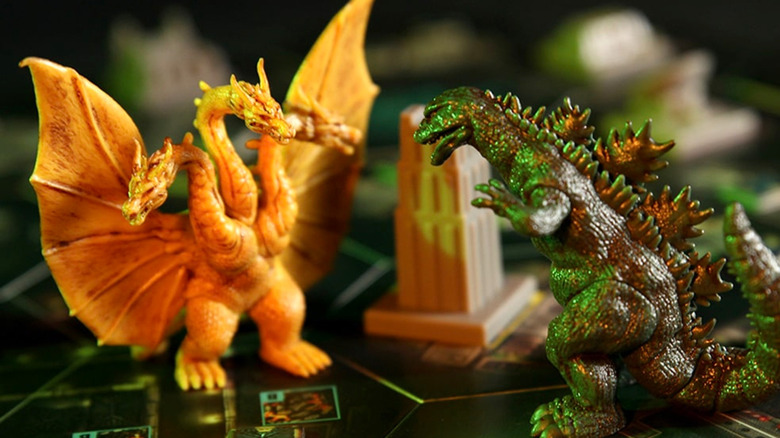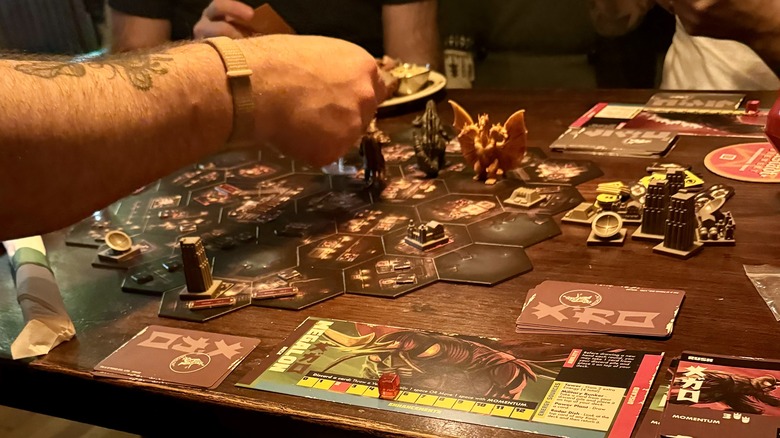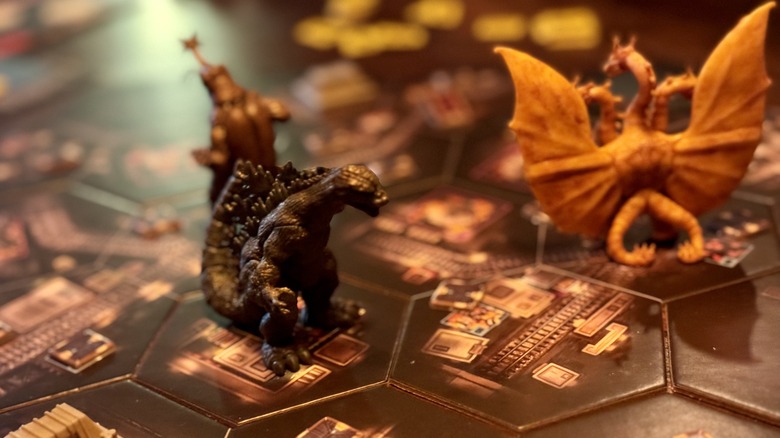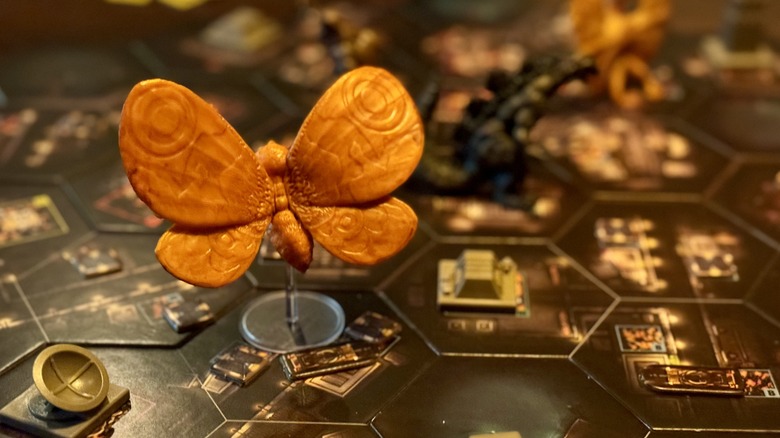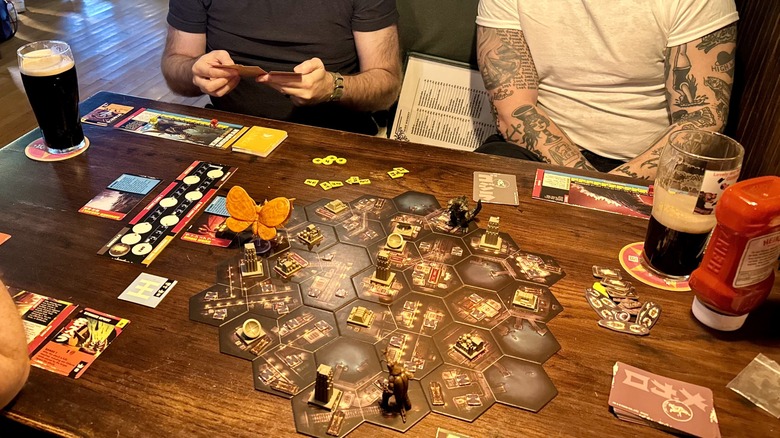Godzilla: Tokyo Clash Gives You All The City-Smashing Gameplay You Crave
Everyone has their cinematic blind spot — that genre or subgenre that, try as you might, you just can't seem to connect with the way others do. For me, that blind spot is kaiju movies. Despite being surrounded by friends who love films in the "Godzilla" and "Pacific Rim" franchises, I've yet to find a monster movie that clicked.
So with "Godzilla x Kong: The New Empire" about to hit theaters, I thought I'd try a backdoor approach to the genre. Would playing a game like Prospero Hall's "Godzilla: Tokyo Clash" help me form a connection to the "Godzilla" franchise? Could I finally warm up to rubber suits if I'm the one doing the smashing? Well, after a heated session with a few of my closest friends, I'm pleased to report that "Godzilla: Tokyo Clash" might be the first thing in the "Godzilla" franchise that I genuinely enjoy.
Breaking down a round of Godzilla: Tokyo Clash
"Godzilla: Tokyo Clash" is a miniatures game built around unique kaiju decks and a modular game board. Each round is broken into four sections. At the start of each round, players advance the Oxygen Destroyer marker on the board, which tracks how close humans are to chasing off the kaiju (and therefore ending the game). This is followed by the Action Phase, where players use or discard cards until every player has passed. The Refresh Phase sees the table draw back up to five cards per player, and finally, the Event Phase triggers the human actions on the map — ranging from military assaults to alien invasions.
Most of the game takes place during the Action Phase, where players use the five cards in their hands to either play effect or activate their kaiju's discard action. These discard actions vary depending on the creature, but can include things like throwing a vehicle into a neighboring space or moving your character with momentum (meaning that you can immediately take another action if you have the energy or cards to do so). Managing your hand — ensuring you have the right mix of offensive and defensive cards for the round — is 99% of the game for players.
The Action Phase ends when all players pass, but be careful: just because a player passes once doesn't mean they are done playing, and the opponent you thought was out of abilities might just be waiting for the board to shift in their favor.
"Godzilla: Tokyo Clash" also allows players to have direct control over their game clock. Each small building you destroy gets placed on the turn counter, and the game ends when your destruction level — which fills in right to left across the board — meets up with the Oxygen Destroyer, which advances in space each round. When a round ends and those two trackers have crossed paths, players count the number of trophies in their hand to determine the victor.
Bashing your opponents is always a good time
Because victory points are tied to trophies, the only real way to win is to beat the everloving snot of our opponents. There are two ways to damage your opponents: targeting them with your unique abilities or tossing various objects (and players!) around the board. For each point of damage you do, you draw one card from their kaiju deck, choosing to keep the one with the highest trophy value at the end of combat. For example, if you use King Ghidorah's Triple Beam ability to do three damage to an opponent in your square, you'll draw three cards from the top of their deck, keep the one with the highest point value, and place the other two in their discard pile.
One of the neatest mechanics of "Godzilla: Tokyo Clash" is its lack of traditional health points. Attacking other players will never knock someone out of the game; instead, you slowly collect cards from their kaiju deck as trophies for your endgame score. This both fits the godlike nature of the monsters in "Godzilla" movies — it's less life-and-death, more about bragging rights — and prevents anyone from being eliminated prematurely. Even the most overpowered attack can only result in a small number of trophies.
Each kaiju also has a custom playstyle meant to highlight their abilities in the movies. King Ghidorah, for example, can grow new heads to add powerful modifiers to his attacks. Mothra moves through the game immune to most human effects while also drawing energy from buildings without destroying them in the process. And then there's Godzilla himself, King of the Monsters, the hardest hitter in the box. He may lack some of the versatility of the other kaiju, but when Godzilla's tail slides into your square, you may as well just hand over your cards and save everyone the effort.
Humans are weak – but important cannon fodder
As you and your opponents brawl your way around Tokyo, you will often brush up against the vehicles and buildings of the humans. These factions are controlled by the board — more specifically, by two event cards randomly selected at the start of each game — and are the game's de facto resource engine. The best way to get the energy you need to play kaiju cards is through the destruction of the environment; each building and vehicle has its own energy point value, and players will spend as much time, say, chucking trains into power plants as they will punching other kaiju in the face.
Given this mechanic, there are times when "Godzilla: Tokyo Clash" feels more like a game of the arcade classic "Rampage" than a deathmatch between players. Humans can't really hurt you, of course, but events like Naval Bombardment or Air Strikes can force you to discard energy or even trophies if you're caught in their path – and destroying human tokens on the board is the best way to keep your energy topped off for your next powerful attack against your opponent(s). Taking a round or two to destroy everything in your immediate area is often the right choice, and players need to carefully balance where they're focusing their destructive energy.
Ultimately, this balance between humans and kaiju is what allows the game to shine. Your focus as players may be on your opponents — zipping up your rubber suit and hitting your buddy with everything you've got — but the ever-present nuisance of humans is what gives "Godzilla: Tokyo Clash" its sense of scope and scale. I don't want the experience of destroying Tokyo to feel too abstract; I want to be able to visualize the path of destruction I leave as Godzilla or Megalon, and the interplay between monsters and the board provides you with a very satisfying sense of scale.
Verdict: Kaiju movies are more fun when you're the monster
Only time will tell if "Godzilla: Tokyo Clash" unlocked the "Godzilla" movie franchise as a whole for me, but after a marathon session — which resulted in some delightfully genuine hurt feelings among friends — I can say that I finally get what other people see. The experience of smashing my way through the miniature buildings and bases on the board was more than a little cathartic, and the interplay between events and human mechanics really made me feel like a demigod.
If you are a "Godzilla" fan and want a board game that will recreate the franchise with more specificity than games like "King of Tokyo," then "Godzilla: Tokyo Clash" is a great pickup for you. Oh, and just in case you were wondering: if you keep the appetizers to a minimum, a four-player game of "Godzilla: Tokyo Clash" is just about the right size for your typical Irish pub booth. You're welcome.
